

China’s Dystopian Lake–Courtesy Of The World’s Lust For Rare Earths. By Paul Homewood Further to my post on neodymium, it is worth taking a closer look at just why China dominates most of the world’s production, their share being estimated at 90%.
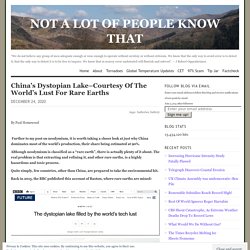
Although neodymium is classified as a “rare earth”, there is actually plenty of it about. The real problem is that extracting and refining it, and other rare earths, is a highly hazardous and toxic process. Quite simply, few countries, other than China, are prepared to take the environmental hit. Back in 2015, the BBC published this account of Baotou, where rare earths are mined: Hidden in an unknown corner of Inner Mongolia is a toxic, nightmarish lake created by our thirst for smartphones, consumer gadgets and green tech, discovers Tim Maughan. From where I’m standing, the city-sized Baogang Steel and Rare Earth complex dominates the horizon, its endless cooling towers and chimneys reaching up into grey, washed-out sky.
Welcome to Baotou, the largest industrial city in Inner Mongolia. Like this: Like Loading...
Baotou toxic lake. The dark side of Green technology. When you consider the push for electrical vehicles (EVs) to replace gas and diesel combustion transports on our roadways, the carbon footprint valuation appears quite attractive.

The batteries that power those EV’s are however dependent on exotic minerals to function which exposes the dark side of green technology. The mere extraction of the exotic minerals cobalt and lithium used in the batteries of EV’s present social challenges, human rights abuse challenges, and environmental challenges. Hazardous working conditions where the workers make such meager wages they live in abject poverty. Impacts of lithium and cobalt extraction - The Current Affairs Documentary. The human and environmental cost of mining lithium and cobalt. The Widespread Social And Environmental Destruction Behind Electric Car Batteries And E-Mobility. German ZDF public television recently broadcast a report showing how electric cars are a far cry from being what they are all cracked up to be by green activists.

Northern Chilean desert being ruined by widespread lithium mining. Image cropped from ZDF documentary: Die Schattenseiten der E-Mobilität The report titled: “Batteries in twilight – The dark side of e-mobility” shows how the mining of raw materials needed for producing the massive automobile batteries is highly destructive to the environment. For example, two thirds of the cobalt currently comes from the Congo, where the mining rights have been acquired by China.
Other materials needed include manganese, lithium and graphite. Fair Trade for Thee, but Not for Me - The Post & Email. Cadmium Green Technologies…VW May Have To Recall 124,000 E-Cars Due To Cadmium Contamination. It appears that green technologies may leave future generations with a heap of toxic waste.
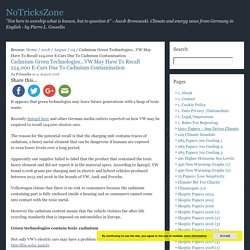
Recently Spiegel here and other German media outlets reported on how VW may be required to recall 124,000 electric cars. The reason for the potential recall is that the charging unit contains traces of cadmium, a heavy metal element that can be dangerous if humans are exposed to even lower levels over a long period. Apparently one supplier failed to label that the product that contained the toxic heavy element and did not report it in the material specs. According to Spiegel, VW found 0.008 grams per charging unit in electric and hybrid vehicles produced between 2013 and 2018 in the brands of VW, Audi and Porsche. Volkswagen claims that there is no risk to consumers because the cadmium containing part is fully enclosed inside a housing and so consumers cannot come into contact with the toxic metal. The Real Environmental Scandal: Out of Sight out of Mines. Pollution Caused By Building a Hybrid Car - Does hybrid car production waste offset hybrid benefits?
Building a hybrid car is almost exactly the same as building a conventional car, requiring high-tech and highly automated assembly lines.
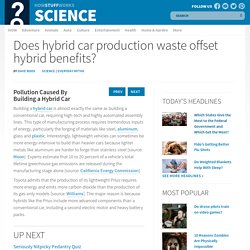
This type of manufacturing process requires tremendous inputs of energy, particularly the forging of materials like steel, aluminum, glass and plastic. Interestingly, lightweight vehicles can sometimes be more energy-intensive to build than heavier cars because lighter metals like aluminum are harder to forge than stainless steel [source: Moon]. Experts estimate that 10 to 20 percent of a vehicle's total lifetime greenhouse gas emissions are released during the manufacturing stage alone [source: California Energy Commission]. How Green are Automotive Lithium-Ion Batteries? This post, part of a series we're running all about electric cars, was written by Kristen Hall-Geisler from HowStuffWorks.com.
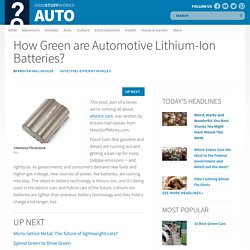
Irony Can Be So Ironic! Grid Storage Increases Carbon Emissions! An Inconvenient truth: Electric-car battery materials could harm key soil bacteria. From the AMERICAN CHEMICAL SOCIETY The growing popularity of battery-powered cars could help reduce greenhouse gas emissions, but they are not entirely Earth friendly.
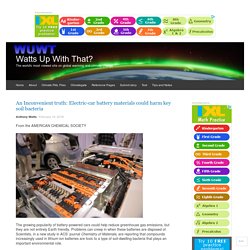
Problems can creep in when these batteries are disposed of. Scientists, in a new study in ACS’ journal Chemistry of Materials, are reporting that compounds increasingly used in lithium-ion batteries are toxic to a type of soil-dwelling bacteria that plays an important environmental role. An estimated 20 million electric vehicles are expected to be on the road by 2020, according to an International Energy Agency report.